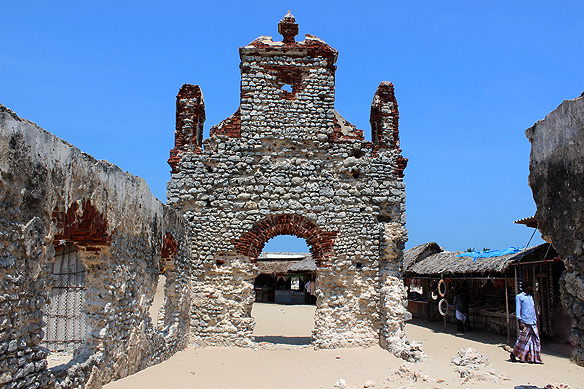
Dhanushkodi.
Meaning ‘End of Bow’.
It is 5:30 am and the alarm on my phone wakes me from my deep slumber with its cacophonic ring. I had slept late last night after taking part in an elaborate ritual at the 12th Century Madurai Temple which drew to a close only around midnight.
Known as the Palliarai pooja, the hour-long event saw the faithful escort Shiva from his shrine to that of his consort Meenakshi’s to spend a night of love-making. A ritual that has taken place every night uninterrupted for the past hundreds of years in the temple’s inner sanctums.
It was slowly dawning on me that in this part of the world common folks honoured their gods with much affection and awe. They were never separate or divided from them. Even their gods’ emotional and sexual desires were fondly celebrated. But more of all that in another post.
Today, I am on my way to Pamban Island connected by a road and railway track over the Bay of Bengal and Arabian Sea. On to India’s international border with Sri Lanka under a radiant blue sky, surrounded on three sides by equally radiant blue oceans. My destination is a tiny patch where land, sea and sky meet, and where one of Hindu mythology’s most significant events took place, at a distance of 192 kilometres south-east of Madurai.
For the devout Hindu, this significant event happened 1.75 million years ago. For the more pragmatic souls, who prefer to be guided by historical evidence, it was between 1000 and 750 BC during the Vedic Age.
Either way, this is the purported spot where Lord Rama, hero of the epic poem Ramayana and the 7th avatar of the god Vishnu, built a bridge with the help of his army of monkeys across the Gulf of Mannar into Ravana’s Lanka to save his wife Sita from the demon-king’s clutches. 35 kilometres long and 3.5 kilometres wide, it was called Rama Setu [Bridge]. Even back then, Dhanushkodi was India’s southern border.
Once his wife was back, Ravana’s good brother Vibhishana entreated Lord Rama that the bridge be destroyed so his kingdom would be safe. Lord Rama obliged and flung his bow. Its end landed at this same spot and the bridge immediately collapsed a couple of feet below sea level, where it still lies under the name: Adam’s Bridge.
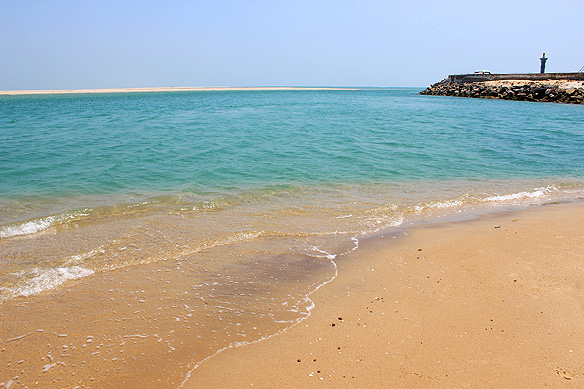
Over the millennia, this strip of sacred myth-steeped land on the south-eastern tip of Pamban Island flourished as a seaport with trade, hotels, pilgrims, and tourists flocking to its sun-kissed beaches. That is, till 1964. On the night of 22 December, 1964, a cyclone with 7-metre-high waves and 280-km-per-hour winds smashed the town to bits.
Meeting sadhus [sages] in such a context is only to be expected. From the sadhu from Uttar Pradesh who I meet on Pamban Road Bridge cycling his way to the four dhams [Puri, Rameswaram, Dwarka, and Badrinath] to Kaliyaman who takes cares of a temple on Dhanushkodi’s coast. When the cyclone destroyed all of Dhanushkodi, Kaliyaman was the only one who survived. And as proof, I get to see a carefully collated photo album filled with newspaper clippings of his childhood face and story.
Nobody lives in Dhanushkodi anymore except for the fisher folks and Kaliyaman. There is no electricity. Nor water. A solitary solar panel on each thatched roof provides for a lone lit bulb at night. When it is high tide, the sea water reaches the edges of the road, often submerging it completely, making it difficult to figure where the tarmac is.
Dhanushkodi was never rehabilitated after 1964. The Indian government is of the conviction that the area is far too prone to natural calamities. No surprises then that all outsiders need to leave the island by 5 pm before high tide, and god forbid, another cyclone strikes.
As I wander, I see the abandoned, haunting ruins of a church, railway station, and a water tank amidst pristine sand dunes. Continuing ahead, I reach the end of the strip of land with the Bay of Bengal to my left, Gulf of Mannar straight ahead, and the Arabian Sea to my right, the wind whipping my hair, and the taste of salt on my lips. Sea horses dance in the crystal-clear waters. Sea gulls swoop over the waves. And silence.
This is what India’s southern border looks and feels like.
Three in the afternoon and I am ready to leave, having had my fill of mythology, ruins, and sun, sea and sand.
No trip to Dhanushkodi is complete without a stop at the famed Rameswaram Ramanathaswamy Temple where the story of Lord Rama continues.
Filled with remorse after killing Ravana, Lord Rama had worshipped Shiva to absolve him of his sins. Ramanathaswamy Temple is built over the same sand lingam he made with his hands and the lingam brought by Hanuman from the Himalayas. The extent of the temple’s sanctity is such, it is believed a pilgrimage to the Kashi Temple in Varanasi is only valid if followed with one to Rameswaram.
Pilgrims are supposed to douse themselves in 22 tirthas or water bodies to achieve penance, with the holiest of holy being the first tirtha outside the temple by the Bay of Bengal. Twenty-one tirthas are inside the temple. I figure, for me, washing my feet in that single first tirtha suffices. After all, what is the point of being human without some [left over] sin. 🙂

Pamban Road Bridge over the ocean with the Indian mainland in the distance.

To my left is India’s oldest and most dangerous railway track, the 106-year-old Pamban Bridge in the Bay of Bengal with its drawbridge section halfway.
Until 1988, when the road bridge parallel to it was built, Pamban Bridge was the only surface transport connecting Rameswaram on Pamban Island with the Indian mainland.
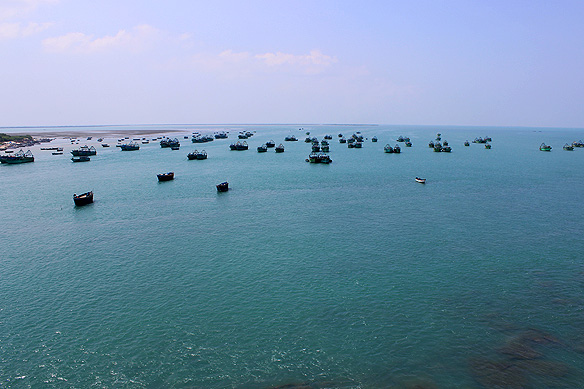
Fishing boats in the Arabian Sea to my right.
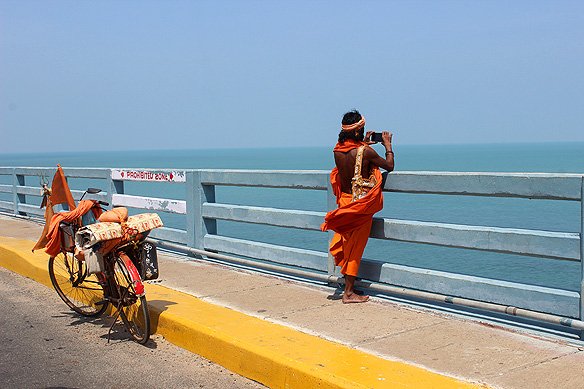
This sadhu gentleman I met on Pamban Road Bridge is visiting all four dhams [pilgrimage sites located in the four corners of India] on his bicycle. After Rameswaram he is setting off for Dwarka in Gujarat.

Blessings to you too.

Huts belonging to the fisher folks—the only current permanent residents of Dhanushkodi.

Before 22nd December, 1964, the border town of Dhanushkodi was a thriving seaport. But then, on the 22nd a cyclone battered it to pieces, killing countless pilgrims, tourists and residents, leaving nothing but ruins and corpses in its wake. Above are the ruins of the church.

This was the railway station and running past it are remains of the railway tracks.
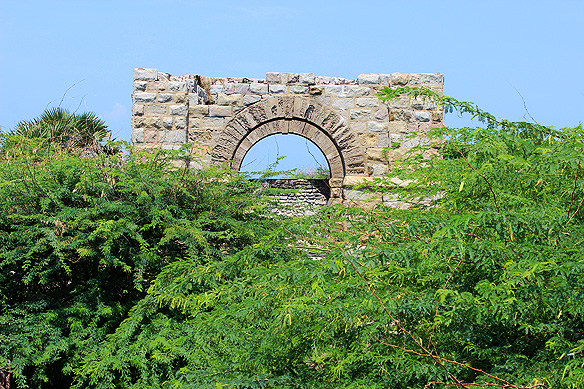
And peeping through the green is what’s left of the water tank.

Left: A concrete pillar topped with a replica of Ashoka the Great’s lion capital and the emblem of the Republic of India stands sentry at land’s end.
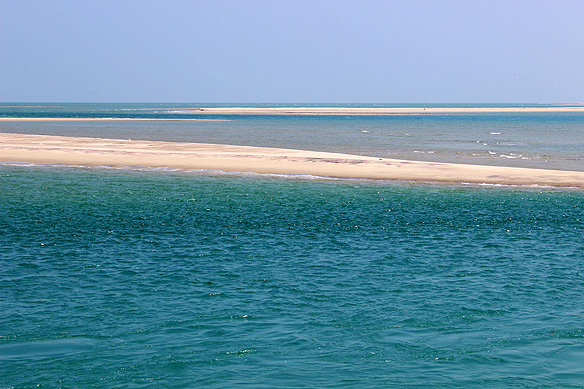
Gulf of Mannar. Across the ocean is Sri Lanka and the legendary Rama Setu.

I am at Dhanushkodi. Where before me, many moons ago, Lord Rama was. And half a century ago, a whole town thrived.

Photo time. I just love the bright colours and silk saris South Indian women carry off with such panache.
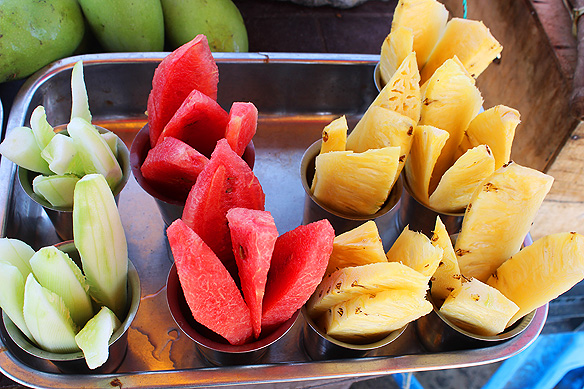
Snack time! Cucumbers, watermelons, and pineapples.

Knickknacks made of sea shells fill the roadside shacks. Left: Shell-framed mirror; Right: Dancing Shiva painted on a sea shell.

Left: Kaliyaman, sole survivor of the 1964 Dhanushkodi cyclone; Right: That’s me with Murugan, my driver from RBC Travels Madurai, who insisted on a selfie. 😀

My last stop in Dhanushkodi before I visit Rameswaram. Vibhishana Temple dedicated to Ravana’s brother, a devotee of Lord Rama, is on a tiny island reached by a ‘side lane’ over the Bay of Bengal. By now, I can safely say, I’m getting used to roads ‘floating’ over the sea. ❤
Travel tips:
- Dhanushkodi: Accessible from sunrise to 5 pm. A paved road goes till the end. Together with Rameswaram it makes for a 12-hour long excursion from Madurai.
- Rameswaram not-to-miss sights: 1) Rameswaram Ramanathaswamy Temple, closed 1:00 to 3:30 pm. Visit it on the way back from Dhanushkodi, timing it for 3:30 pm for minimal crowds and a leisurely darshan. 2) A.P.J. Abdul Kalam Memorial [includes a museum on former Indian president’s life and achievements].
- Photography is not allowed in any of the temples or the Memorial.
- Getting there: I hired a car with a driver from RBC Travels Madurai. Super professional with great vehicles at competitive rates. Highly recommended!
- Eating: There are no restaurants [or bathrooms] in Dhanushkodi. Plan all pit stops for Rameswaram.
[Note: This blog post is part of a series from my solo and independent travel to the temple towns of Tamil Nadu over 7 days in the first week of March 2020. To read more posts on Tamil Nadu, click here.]

If the COVID-19 glitches were not in this world, probably I would have been in Madurai with my mom this month. Thanks to your article my excitement lifted again to travel Tamil Nadu 😄 ( maybe after 2 to 3 months). Keep up the good work!
LikeLiked by 1 person
I loved Tamil Nadu! So grateful I got to explore it in early-March.
Many thanks for your kind words, Vidya. I’m glad the post lifted your spirits and made you look forward to travelling to the state! There is lot’s more coming up. From the UNESCO-listed Chola temples to Chettinad. From the Danish town of Tranquebar to the temple towns of Chidambaram and Kumbakonam. I hope you enjoy the rest of the series too. 🙂
LikeLiked by 1 person
Yaa I love to read the upcoming series and can plan better this time to visit those sites. 😄
LikeLiked by 1 person
Till then, Stay safe. Stay healthy. 🙂
LikeLiked by 1 person
Nice flow of experience with excellence in discription. Keep the Good Going..
LikeLiked by 1 person
Welcome to my blog, Kovai Kirupa and your kind words. Stay safe. Stay healthy.
LikeLike
Well written
LikeLiked by 1 person
Thank you, Ranjini. Am glad you enjoyed the read. Keep well.
LikeLike
Please follow my blog too … I have written about the temples I have been to .
LikeLiked by 1 person
Will surely read your posts, Ranjini. 🙂
LikeLike
Thank you Rama !
LikeLike
Awesome travel blogging! These factual descriptions transported me to dhanushkodi!! Way2go!!
LikeLiked by 1 person
Am truly happy and grateful you enjoy my posts. Dhanushkodi was beautiful. Unlike any other place I have been to. Writing about my travels is helping me get through the current lockdown. It keeps my hopes up that I will be able to travel again. 🙂
LikeLiked by 1 person
You’re a spirited traveler Rama!! I’ve always enjoyed reading your posts!! Keep up the good work! These posts are truly an escape from the current grim situation of lockdown!
LikeLiked by 1 person
Thank you. This too shall pass. Stay safe. Stay healthy. 🙂
LikeLiked by 1 person
You too! Fingers crossed 🤞🏻
LikeLike
https://httpranjustraveldiaries.travel.blog/2020/04/04/udipi-krishna-temple/ link to my blog
LikeLiked by 1 person
The destroyed church and the bridge are the most common images of Dhanushkodi one comes across. Must have been very hot.
LikeLiked by 1 person
It was. Scorching hot. And this was first week March. Can only imagine what it must be like in the height of summer! Dhanushkodi was a fascinating place. The journey, as incredible as the destination. I am glad I went. 😊
LikeLiked by 1 person
I was in this area last June and thought of visiting but skipped owing to terrible heat.
LikeLike
Wow! I’m from Sri Lanka, and its so lovely to see images of Dhanushkodi. I myself haven’t yet been to Mannar but its definitely top on my local bucket list as the sunken landmasses that some say are the Adam’s Bridge between Talaimannar and Dhanushkodi has always intrigued me. Thanks for sharing.
LikeLiked by 1 person
Hello Dinali! Wonderful to have a Sri Lankan enjoy this post. I used to live in Kandy from age 4 to 7. My dad was posted in Sri Lanka at that time. I do not remember much except it was all wonderfully green and hilly. I hope to go back someday. Dhanushkodi is fascinating. What was also interesting is that because of the proximity to Sri Lanka, the signal on my cell phone was showing I was under your country’s range. 😀
LikeLike
Hi Rama..so amazing how close in proximity these two areas of our countries are 🙂
Yes Kandy is still as lovely as you remember. Glad to hear you are hoping to visit. I hope these unfortunate times will pass soon and you will be able to.
LikeLiked by 1 person
Hope so too. And that you as well can cross over and see Dhanushkodi this side of the seas. Stay safe and healthy.
LikeLiked by 1 person
very interesting and useful information. Thanks.
LikeLiked by 1 person
Thank you for stopping by and commenting, Ankur. Appreciated. I am glad you enjoyed the post.
LikeLike
Welcome to my blog, Ankur. Glad you enjoyed the post. Dhanushkodi is a fascinating place.
LikeLike
Pingback: palaces of madurai and thanjavur | rama arya's blog
Amphan hits parts of Odisha and West Bengal.
LikeLiked by 1 person
And history [almost] repeats itself. Welcome to my blog, The Liberacy. 🙂
LikeLike
Hi! Please check out my blog!
https://themysticwagon.wordpress.com/2020/05/27/covid19-pairs-up-with-amphan-the-tale-of-two-disasters/
LikeLike
Thank you for sharing your post, Aahana. Will definitely read it. 🙂
LikeLike
Nice post
LikeLiked by 1 person
Thanks much, Swapnil for stopping by and dropping a comment. Appreciated. 🙂
LikeLike